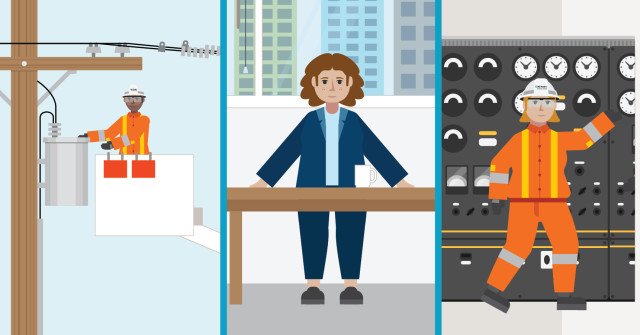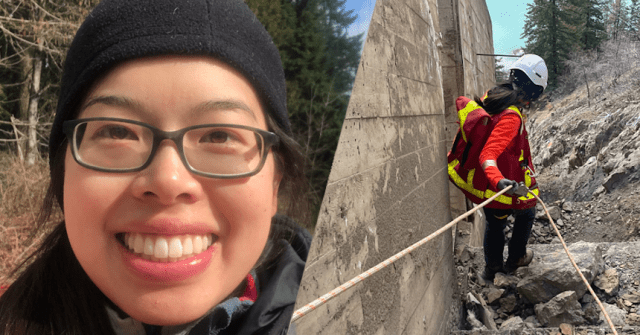Women in science, and the value of STEM education
Eva Brooke learned about archaeological sites along the west coast from her fisherman dad, who had a degree in anthropology. Today, she's a professional archaeologist at BC Hydro.
Jen Evans recalls being inspired by teachers to enter science fairs in elementary school. And while her attempt to build a groundwater model in Grade 7 didn't quite work out, her interest was piqued. She's now a senior environmental coordinator with a small pollution prevention group at BC Hydro that tackles contaminated sites.
At age five or six, Eva Wichmann got the green light from her parents to keep bullfrogs in the tub for the summer – collecting bugs to feed them each day – before sending them back to the wild in the fall. She's now in BC Hydro's environmental field operations group, working out of Campbell River to help minimize the environmental impact of BC Hydro operations and work.
On the cusp of International Day for Women and Girls in Science (Feb 11), we talked to the three women about their education and career paths. And while there's still a gender gap in STEM (Science, Technology, Engineering, Mathematics) jobs in Canada – only about 25% are filled by women – all three say they've never experienced any real barriers as women.
"Here at BC Hydro, it's a very diverse workplace," says Wichmann, a science and biology graduate from the University of Western Ontario. "And even earlier on, at summer jobs working for engineering companies, I was lucky – I saw a number of women working in engineering roles. Even working in a male-dominated field, I never felt inferior."
"My parents and family never treated me differently for being a woman," says Brooke, who got her Masters in heritage resource management at Simon Fraser University after first getting her Bachelor's degree in anthropology with a minor in environmental planning at the University of Northern B.C. in Prince George. "And there are a lot more female archaeologists today than there used to be, along with a better understanding of the importance of heritage and exposure to archaeology at job sites."
"I've always felt encouraged," says Evans, who earned her microbiology degree at the University of Victoria, then studied environmental engineering at BCIT. "I grew up with a mom who was a single parent and she always encouraged me to do whatever it was that made me happy. And over time, I've noticed an increased acknowledgement of women in the workplace."
Appetite for STEM education and careers needs to grow
One thing that's hurting STEM education in Canada, for both female and male students, is a limited appreciation for the value that STEM education offers.
Let's Talk Science, which received a $10,000 BC Hydro community grant in 2022 to help fund its volunteer outreach efforts at schools, wants to dramatically increase interest in science. More than half of all Canadian students still graduate high school without a senior level math and/or science credit, and only 17% have finished Physics 12.
Andre Motuzas, Let's Talk Science's Director of Development Operations, the myth persists that STEM courses are only for those going into university programs that require them. He says that it's now a must-have for those in skilled trades and in a variety of other professions.
"We really want people to know that STEM isn't just about working in a lab or being a science teacher," says Motuzas. "It's involved in so many different jobs."
The Government of Canada also strongly recommends STEM education for all, in part due to the spread of science misinformation and the need for young Canadians to think critically about what they digest. BC Hydro Senior Environmental Coordinator Evans couldn't agree more.
"I would hope that critical thinking is now taught as a component of science education," says Evans. "I think it's super important to learn how to analyze information, especially with how much information is available in the 21st century and when it comes to topics such as climate change that impact all of us."
Those different perspectives can also come from travel, says fellow BC Hydro employee Wichmann. After finishing university, she worked at an anatomical institute in Munich for the summer, and later went to Switzerland to work at a pharmaceutical company before returning to Canada. "Pursuing a career doesn't mean that you have to give up things like travel," she says.
How teachers can help increase girls' interest in STEM
A 2021 study by Statistics Canada looked at gender differences in STEM enrolment and graduation at the university level. It found that among high school graduates, women are 29.8% less likely than men to enroll in a post-secondary STEM program shortly after graduation. It also suggests that while girls tend to perform as well as boys in STEM courses at the Grade 10 level, fewer choose to continue with STEM courses in Grades 11 and 12.
Another similar StatsCan study – on persistence and representation of women in STEM programs – cites an oft-used metaphor to explain that gap: a STEM pipeline that leaks. It found that women’s self-identification with math and sciences is lower than that of men, and that even women who report strong self-identification with math and sciences are less likely than men to intend to pursue a major in those fields.
STEM educators concerned about that gender gap recommend a number of ways teachers can encourage girls to both pursue STEM learning and to stick with it.
Encourage STEM learning outside the classroom: Science World in Vancouver, and the Okanagan Science Centre in Vernon, offer numerous fun exhibits, camps, and events. For younger girls, recommend STEM toys such as GoldieBlox products. Let's Talk Science has a variety of STEM-related home-based activities for kids as young as three, plus a broader set of resources that can be searched by curriculum.
Promote after-school STEM clubs and programs: There are numerous options, including the UBC's girls-only Maker Camp, and in-person and online workshops offered by Canada Learning Code. Across the province, programs include: EUReKA (Thompson Rivers University), Science AL!VE (Simon Fraser University), Active Minds (University of Northern B.C.), and Science Venture (University of Victoria).
Volunteer to mentor girls in STEM: Science World offers the SIS program, the YWCA runs a high school mentorship program in the Lower Mainland, and SCWIST's e-mentoring program includes both online and community-based options. You can request a Let's Talk volunteer to lead STEM activities in-class or at community events, or you can volunteer with Let's Talk Science, as a student or as an industry professional.
STEM-related activities
There's a wealth of STEM-related activities and resources offered by Power Smart for Schools. Here are a few examples:
Science of climate change (Grade 7)
Students get facts about climate change through videos, experiments, and hands-on learning.
Electromagnetism (Grade 7)
Over four activities, students investigate the wonder of magnetic fields, create a magnetic field with electrical circuits, and build an electric motor and electromagnet.
Resistance (Grade 7)
In two activities, students learn how current and voltage can be changed by creating series and parallel circuits with a variety of resistors.
Atomic models and electricity (Grade 8)
Linking to the Big idea that behaviour of matter can be explained by atomic theory, students will understand how atomic theory can be used to explain and understand the generation and movement of electricity.
Law-abiding systems (Grade 11)
Provided with a list of different systems students are asked to identify which systems – including a hydroelectric dam – would satisfy Kirchhoff’s laws. A set of required for systems that satisfy Kirchhoff’s laws and an interpretation of hydroelectric dams as “circuits”.
Forces in and out of balance (Grade 11)
How often do Newton’s 1st and 2nd laws apply in the same situation? Students decide whether there is a greater overlap between the laws and concepts of static and dynamic physics to real-life scenarios than there may appear to be at first glance.
Energy conversion and efficiency (Grade 11)
Students explore where energy is lost when generating electricity.
Electric vehicles (Grade 11)
Over two activities, students think critically about technological innovations used in electric vehicles.






